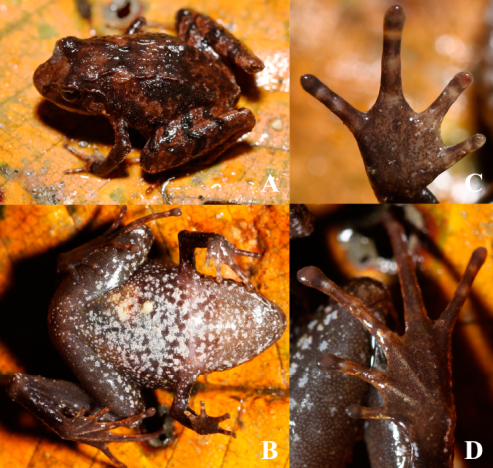
Recently, Prof. CHE Jing's group at Kunming Institute of Zoology (KIZ) of Chinese Academy of Sciences discovered a new species of the genus Liurana Dubois, 1986 from Medog County, Tibet autonomous region, China, and named it Liurana vallecula sp. nov. (English common name: Valley Papilla-tongued). The “vallecula” means “valley inhabitor”, in reference to the habitat of this species in the lower river valley of Yarlung Zangbo Grand Canyon.
The main findings were published online in Zoological Research. Other than describing the new species, this study addressed the problems of the distinct distribution pattern, direct developing reproductive mode, and conservation status of the genus Liurana.
During a field surveys in Bomê and Medog Counties of the Nyingchi Prefecture, southeastern Tibet, from 2012 to 2016, researchers collected 20 specimens of the genus Liurana. Among them, two specimens (one male and one female, deposited in the Museum of the KIZ) were identified as the new species of L. vallecula sp. nov. based on morphological and phylogenetic analysis.
The body size of L. vallecula sp. nov. is rather small. The snout–vent lengths of the female and male specimens were only 20.4mm and 14.6mm, respectively.
The new species is characterized with relatively wider head and longer hindlimbs, with tibiotarsal articulation reaching beyond tip of snout when adpressed, as well as distinct tubercles near the cloaca. It is also featured with transverse bands distinctly on dorsal limbs, four bands on thigh and three on tibia, and dark brown marbled patterns or speckles on white belly.
Within Ceratobatrachidae family, frogs of the genus Liurana represent an understudied yet fascinating endemic group from the East Himalaya region.
"The frogs of family Ceratobatrachidae are featured with significant variations, morphologically, developmentally, ecologically, and biogeographically, i.e., variable body size, direct larval development, and the ability to inhabit a wide variety of environments that lack standing water-from small oceanic islands, to high elevation mossy montane forests," said Prof. CHE.

Figure: Holotype of Liurana vallecula sp. nov. in life (adult female) A: Dorsolateral view; B: Ventral view; C: Ventral close-up of hand; and D: Ventral close-up of feet. (Image by WANG Yufan)

86-10-68597521 (day)
86-10-68597289 (night)

52 Sanlihe Rd., Xicheng District,
Beijing, China (100864)

